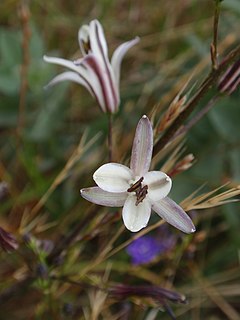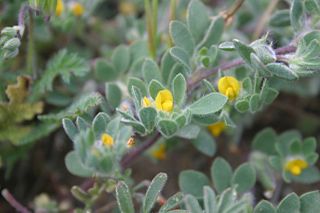
Pinus ponderosa, commonly known as the ponderosa pine, bull pine, blackjack pine, western yellow-pine, or filipinus pine is a very large pine tree species of variable habitat native to mountainous regions of western North America. It is the most widely distributed pine species in North America.

Chlorogalum pomeridianum, the wavy-leafed soap plant, California soaproot, or Amole, is the most common and most widely distributed of the soap plants, soaproots or amoles, which make up the genus Chlorogalum of flowering plants. It is occasionally known as the "wild potato", but given the plant's lack of either resemblance or relationship to the potato, this name is not recommended.

Lotus, a latinization of Greek lōtos, is a genus of flowering plants that includes most bird's-foot trefoils and deervetches and contains many dozens of species distributed worldwide. Depending on the taxonomic authority, roughly between 70 and 150 are accepted. Lotus is a genus of legumes and its members are adapted to a wide range of habitats, from coastal environments to high altitudes.

Eriophyllum lanatum, with the common names common woolly sunflower and Oregon sunshine, is a common, widespread, North American plant in the sunflower family.

Frangula californica is a species of flowering plant in the buckthorn family native to western North America. It produces edible fruits and seeds. It is commonly known as California coffeeberry and California buckthorn.

Salix lasiolepis is a species of willow native to western North America.

Cupressus forbesii, now reclassified by some as Hesperocyparis forbesii, and with the common names Tecate cypress or Forbes' cypress, is a species of cypress native to southwestern North America.

Arctostaphylos glandulosa, with the common name Eastwood's manzanita, is a species of manzanita.

Eryngium aristulatum, known by the common names California eryngo and Jepson's button celery, is a species of flowering plant in the family Apiaceae.

Sambucus racemosa is a species of elderberry known by the common names red elderberry and red-berried elder.
Linanthus killipii, known by the common name Baldwin Lake linanthus, is a rare species of flowering plant in the phlox family.

Hosackia gracilis, synonym Lotus formosissimus, is a species of legume native to western North America from British Columbia through Washington and Oregon to California. It was first described by George Bentham. It is known by the common name harlequin lotus. It grows in moist spots in the coastal mountains and down to the oceanside bluffs. It is a perennial herb growing upright or spreading to about 0.5 m in maximum length. It is lined with leaves each made up of a few oppositely arranged oval leaflets up to 2 cm long. The inflorescence is made up of several pealike flowers each 1 to 2 cm long. The flower has a bright yellow banner, or upper petal, and bright pink or white lower petals. The fruit is a legume pod 2 to 3 cm long.

Acmispon brachycarpus is a species of legume known by the common name foothill deervetch. It is native to western North America from Idaho to Texas to northern Mexico, where it is known from many types of habitat. It is an annual herb spreading upright or taking a clumpy or matted form. It is lined with leaves each usually made up of four hairy, somewhat fleshy leaflets each up to about 1 cm long. Solitary yellow, pea-like flowers appear in the leaf axils. The fruit is a legume pod variable in size and shape.

Diplacus jepsonii, formerly classified as Mimulus nanus var. jepsonii, is a species of monkeyflower known by the common name Jepson's monkeyflower.
Navarretia setiloba is a rare species of flowering plant in the phlox family known by the common names Paiute Mountain pincushionplant and Piute Mountains navarretia.

Sidalcea oregana is a species of flowering plant in the mallow family known by the common name Oregon checkerbloom.
Trifolium barbigerum is a species of clover known by the common name bearded clover.

Berberis dictyota, now reclassified as Berberis aquifolium var. dictyota, with the common names Jepson's oregon grape and shining netvein barberry, is a flowering plant in the Barberry family.
Galium jepsonii, with the common name Jepson's bedstraw, is a rare flowering plant species in the Rubiaceae — Madder family.

Fritillaria biflora var. ineziana, the Hillsborough chocolate lily, is a species of fritillary endemic to San Mateo County, California. It grows on serpentinite in cismontane woodland and valley and foothill grassland at elevations that range from 295 to 525 feet It is typically found on serpentine soils and it is defined as a "broad endemic" where 85-94% of occurrences are expected to occur on ultramafic soils.















